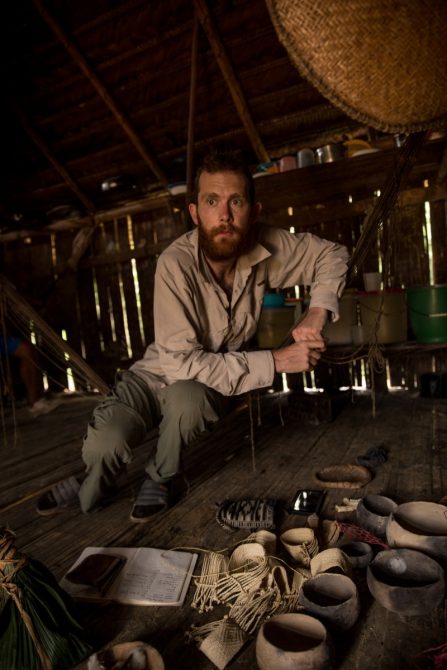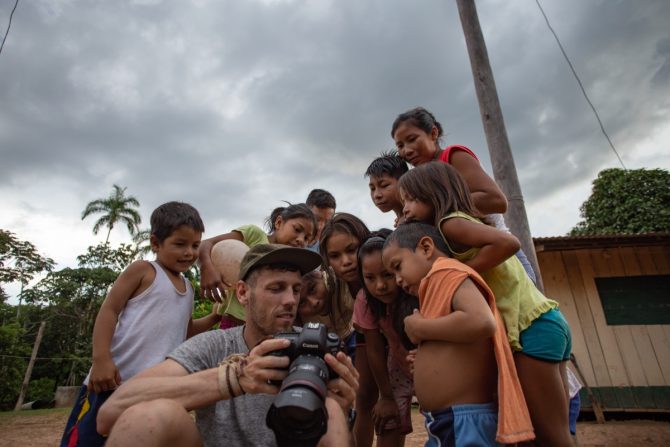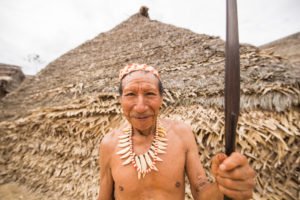
Bridging Cultures through Art: An Interview with Xapiri
In our latest field report, we profile the extraordinary work behind the Matsés Handicraft Initiative, our project in partnership with Xapiri. Through this program, timeless ancestral artistic practices are maintained and transmitted to younger generations and much needed economic opportunities are generated for Matsés elders and youth.
Successful sustainable economic projects are the Holy Grail of conservation initiatives. They are the hardest to develop yet offer the best hope to stem the tide of rainforest destruction worldwide. Too often, international rainforest conservation efforts aiming to combat destructive economic activities, such as logging and poaching, place little or no attention on creating viable economic alternatives for local communities. Even the most recently contacted indigenous people, such as the Matsés, are increasingly drawn into the cash economy. Even though they still largely subsist on traditional activities and retain a high degree of self-sufficiency they need cash to obtain basic household needs such as clothes, blankets, pots, and medicines. If real economic alternatives that support local livelihoods are absent, then conservation efforts are doomed to ineffectuality.
For this reason, sustainable economic development has been the first pillar of Acaté’s programs since its founding. The genesis of the Matsés Handicraft Initiative occurred in a meeting with the Matsés in May 2016. Toward the end of the meeting, Carmen Rodriquez Lopez, a Matsés woman from the village of Buen Peru, stood up and powerfully addressed the assembled leaders from the 14 villages. She pointed out that the economic programs developed with Acaté so far, such as the sustainable harvesting of the valuable resin from the heartwood of large copaiba trees, have centered largely on activities done by men. She pointed out that Matses women have valuable skills and want to contribute to developing economic opportunities for their families. Carmen held up a fistful of beautiful woven friendship bracelets called uitsun by the Matsés. Although these bracelets are still worn by the Matsés as accouterments of daily life, Carmen lamented that the knowledge of their craft was not being passed down to the younger Matsés women.
While the passion and commitment of the Matsés women is strong, the market demand for their exquisite and beautiful handicrafts did not exist. Over the decades, conservation organizations in the Amazon have launched well-meaning handicraft projects. Sadly, many fall short of realizing true economic viability due to the lack of demand and never get past the development stage. Furthermore, handicraft initiatives with other indigenous groups living in remote areas of the Amazon typically source from only a small handful of individual artisans located in the most geographically accessible villages. The Matsés are a remarkably egalitarian people and they have reiterated to us on many occasions the importance of involving as many members of their communities as possible so that the benefits can be equitably shared.
It was in this spirit that the Matses Handicraft Initiative was launched in 2016 in close partnership with Xapiri. Xapiri is committed to providing an economic outlet for indigenous communities in the Amazon through developing a global market for their handicrafts and promoting awareness of indigenous culture. Since the first order of uitsun bracelets from the Matsés, the project has now expanded to nearly all the Matsés communities in Peru and involves dozens of Matsés artisans. The initiative has brought renewed interest and economic opportunities to the Matsés and has expanded to include almost all of their traditional handicrafts including black palm wood spears crafted by Matsés elder warriors and beautiful ceramics created by the last remaining artisans who hold knowledge of this vanishing art.

Last year, Jack Wheeler, Tui Anandi and Mike van Kruchten of Xapiri joined Acaté in our trip to the Matsés territory and spent a further several weeks visiting Matsés communities across their lands in Peru, meeting Matsés artisans and documenting the processes behind the art. Their reporting and beautiful photography in the Ancestral Transmission series that followed provides an intimate glimpse into Matsés culture and daily life as never seen before. We recently sat down with the Xapiri team to learn their impressions of the Matsés, the genesis and future directions of their work.
An Interview with Xapiri
What is the mission of Xapiri and the genesis of the organization? What realizations or experiences led you to found Xapiri?
Xapiri is an art gallery, shop, and cultural platform dedicated to supporting indigenous communities in the Amazon. Our mission supports Amazonian indigenous culture by unifying ethical art, emotive photography and informative media. In simple terms, we want to increase awareness and inspire positive change for the Amazon and all the people that inhabit it. We believe, inherently, that as humans, all of our futures are intertwined. So, if we can get outsiders interested in the indigenous cause, then that can naturally translate into a perceived sense of personal obligation and investment in the future of indigenous peoples in the Amazon, and in the Amazon itself. In the Western world, I believe there’s this perceived sense of separation between people and landscapes. Still today, when people think of ‘The Amazon,’ the image conjured in their mind is of unending swaths of forest, and people kind of forget that there are over a million people inhabiting this forest, caring for it, existing within it. We want to break that down. We want to make these communities relatable to the outside world, so that people care about them.

What better way to do this than to share that which is common among us all: art. Art has this ability to transcend language and borders and culture. Aesthetics speak to everyone. So, if someone sees a textile and feels called to it, that emotional connection to a textile in some ways creates an emotional connection between the person who made it and the person who buys it. They are now connected.
So, that’s what we do.
The genesis of Xapiri began from extensive travels through Latin America, and this intrinsic desire and passion to bring awareness to all of these amazing cultures that I had the chance to experience. More than anything, what I took away from these travels and the time spent among indigenous communities was a new way of seeing the world, and a living example of what it looks like to exist in harmony with all of life. Xapiri was born in response to this: a way to share these cultures with the outside world because I believe that there is so much that we can learn from them. And really, these lessons that we can learn from them can help shape the future of humanity for the better. So Xapiri is not just a platform to share the wisdom that these cultures have to offer, but a way for someone to take a little piece of that culture home with them back into their daily life, as a reminder to live within that harmony.
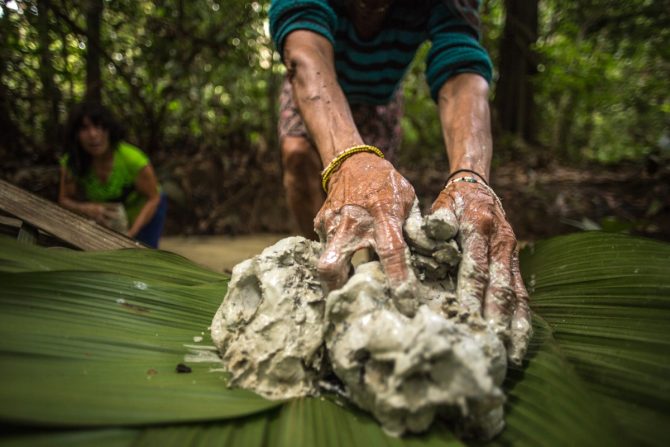
Preparation of pots begins with collecting clay from the rainforest
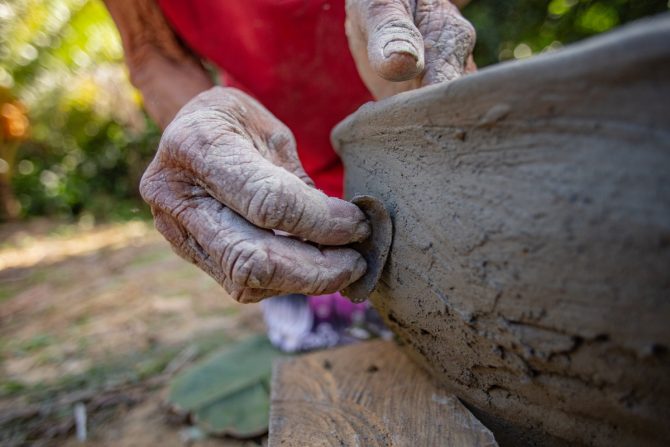
The pots are hand shaped then carefully polished with the shell of a fresh water clam
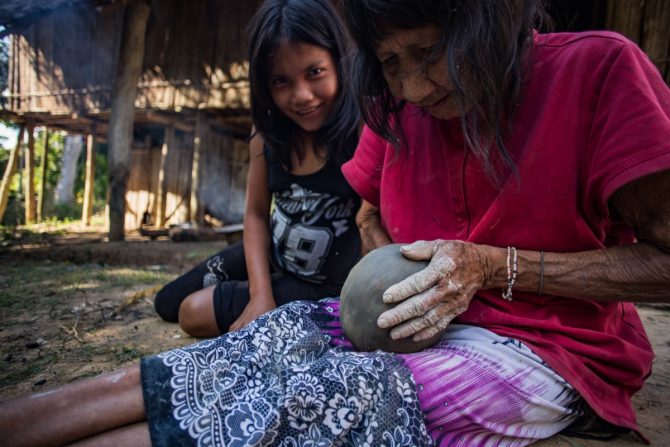
At the time of the start of the project, the art of traditional ceramics was on the verge of being lost, with the knowledge held only by a few elder Matsés women. Now this knowledge is being passed on.
In comparison to other indigenous art, e.g. African or South Pacific, the market for Amazonian handicrafts was historically been underdeveloped. What are some of the challenges and difficulties in creating a sustainable, real-world market for indigenous handicrafts? Through your work, what benefits did you seek to create for indigenous communities and what do you hope to share to the world?
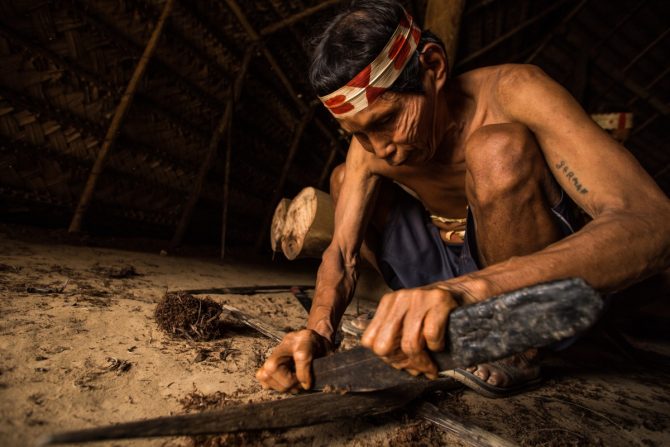
Absolutely – I think still, to this day, in comparison to other regions like Africa or the South Pacific, the Amazon continues to be shrouded in a sense of mystery to the outside world. Some of this mystery is a simple result of geography and infrastructure: the Amazon has been historically and contemporarily inaccessible to outsiders, just based on travel routes. You look at Saharan, Swahili and Asian trade routes, and those have been in place for centuries; so following the advent of capitalism and globalization, the ability to open up markets for artisan artwork was already inherently a little easier.
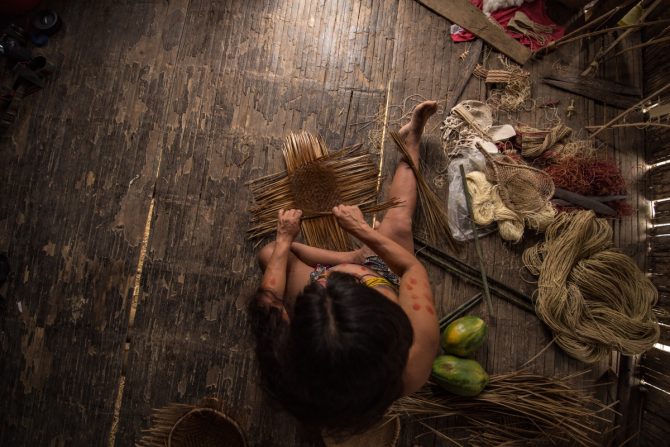
When we think about opening up markets, or looking at trade routes, we can use water as a metaphor. When rain pours down and hits the soil, water runs first where it has run before. Creeks swell and water gathers, and then flows, in the easiest way it can find. It’s as much a law of gravity as it is a law of ease. It is only until one stream hits its capacity that water naturally trails outside its normal route to carve a new path where water can flow.
This lack of accessibility, a result of the dense, and at times harsh, ecology of the place, has both been a protecting force for the Amazon and its people, but has also made it more difficult for the little guys like us to carve futures of sustainability. But at the end of the day, opening this market to an international audience, while daunting at times, has overall been an exciting role to take as a pioneer in this field.
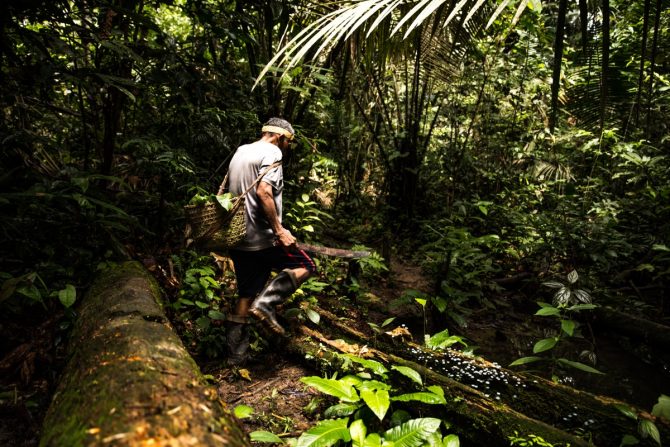
Overall, the benefits we seek to create for Amazonian communities are simple in theory, but takes patience and slow-growth to realize them. When we get down to the guts of things, we live in a world whereby invisible, but impactful, power relations have been cemented over centuries. These power dynamics leave indigenous communities vulnerable to continued exploitation, even if it’s not as explicit as in centuries past. Such imbalanced power isn’t unique to the Amazon, but covers any historically marginalized group of people. We believe these communities should have the ability to enter the cash economy on their own terms, and have an alternative option to the more destructive income generating activities present in the region–whether it be timber extraction, gold mining, working for an oil company, or the simple, but equally detrimental, lures of urbanization.
We feel that if communities have a way to generate income that aligns with their values and does not necessitate the migration to urban centers, then these communities will have the autonomy and agency to maintain their cultural traditions and be the sole authors of their communities’ futures. We feel we can play a small role in making that a feasible reality, simply by being the bridge to these outside markets.
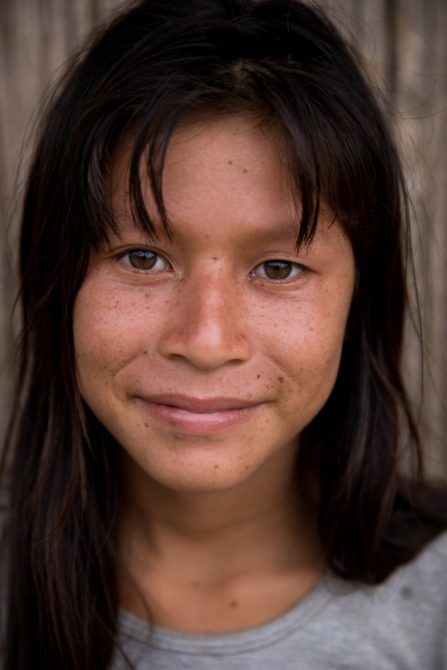
It is because of these cemented power relations that we feel our presence is beneficial: it’s almost necessary that these communities have an ally to advocate for them as they enter the cash economy. Because, if not, more than likely, they will be taken advantage of. We, at Xapiri, are already fluent in the metaphorical language of capitalism and modernity; if we can act as the proverbial translator between these outside markets and these communities, we feel that these communities can enter the cash economy in a way that benefits them.
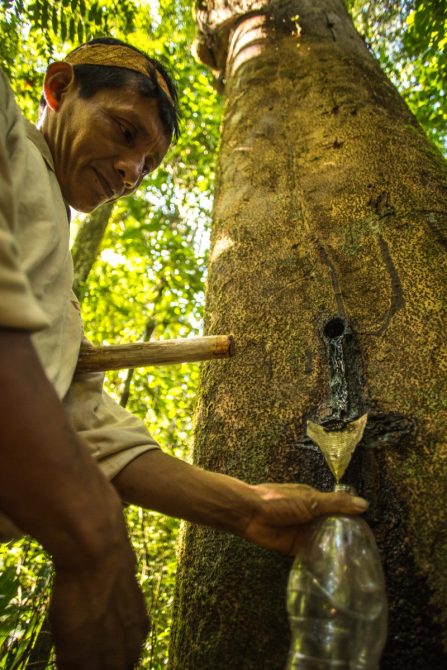
As for the outside world? First and foremost, we want to connect people to the Amazon and its inhabitants, and we do that through the art. But perhaps less direct, we want to demonstrate that the fate of indigenous people has not yet been sealed. There’s kind of a growing air of pessimism in our world regarding both the trajectory of indigenous people and the trajectory of the environment. I think a lot of people feel like the momentum of the powers that be are too large and too insurmountable. But what we want to communicate at its core is that, it is surmountable. We can create a new future, whereby indigenous peoples have rights, have a voice, have agency, and therefore, can continue to thrive in this world. And we too, are a part of that story.
When did your work with the Matsés and Acaté begin? What did you set out to accomplish in the partnership and how has it developed over time?
The first conversations with Chris and Acaté started in 2015, and our initial aim the following year was to develop a market for the woven Matsés cuffs knows as the ‘Uitsun.’ The first samples were sent to the UK and we began to promote them via our online store. Working organically, we began to slowly increase the sales of the uitsuns, and naturally, we began talking with Acaté about what other Matsés artefacts could be suitable for an outside market.
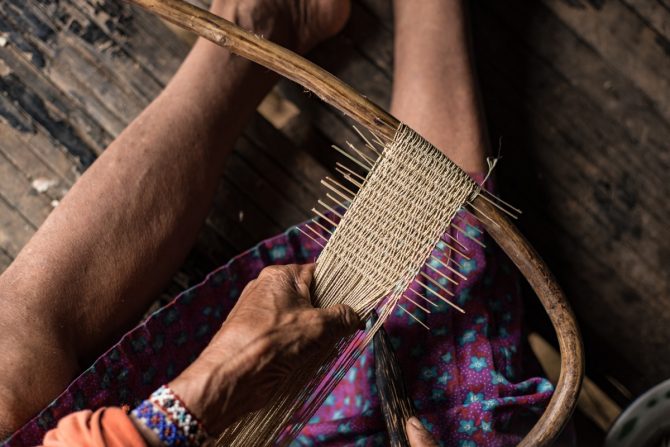
Always in our conversations with Acaté and the Matsés is how to ensure that we are, as outsiders, propelling opportunity in a way that serves the Matsés. When implementing any outside-driven project, you have to be careful about unintended consequences, good or bad. Through conversations with Acaté and the Matsés, we realized a need to balance economic opportunity for both genders. As the uistuns are made solely by the women in the villages, we began to explore economic opportunities and crafts produced by the men in the village, so as not to disrupt or bring out of balance gender relations within the communities. Out of this conversation came the idea to ask the men to make miniature versions of their arrows and lances, which have also proven to be a success. With time, more handicrafts appeared and the trade grew, from woven bags to hammocks to necklaces and so on.

Shortly after opening our space in Cusco, two years after the relationship with the Matsés and Acaté had begun, we heard for the first time about the Matsés ceramics. This news was kind of a ‘eureka’ moment for us, as it was the first time that the Matsés had shared their ceramic tradition, which is on the verge of dying out, with the outside world. We realized that this model of putting intentional, commercial value on these artifacts can actually be a credible source of cultural preservation.

Today, our relationship with both the Matsés and Acaté has reached a level we could never have dreamed of. What began as a conversation to source one item from the Matsés, with Acaté as the point of contact, has now turned into an intimate allyship between these three entities: us, Acaté and the many Matsés communities.
The success of our relationship with the Matsés is really thanks to Acaté as an organization. The reason we’ve been able to deepen our relationship with the Matsés so quickly, without losing an ounce of integrity during that fast growth, is testament to the groundwork and delicate relationship-building that Acaté has made over the past several years with Matsés communities. If it wasn’t for Acaté, our ability to execute such extensive programming while creating true, authentic relationships with these communities would not only be difficult, but perhaps impossible.
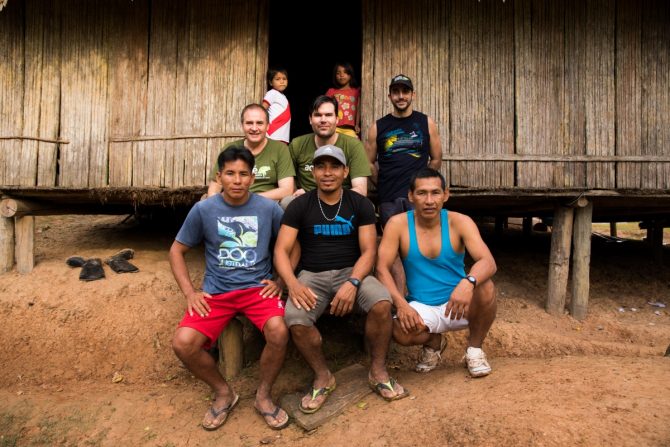
Acaté Amazon Conservation team members: Front row from left to right; Mariano Lopez Rengifo, Felipe Ëpë Bai Unan and Segundo Shabac Reyna. Back row from left to right; William Park, Christopher Herndon, David Fleck.
We see and hear of many different organizations out there working with different tribes in the Amazon, and more often than not, while having good intentions, the truth is, most of these organizations are out of touch with the true realities that these communities exist within. Acaté, in our eyes, is the standard to which all organizations should strive towards in terms of how they integrate indigenous voices into the bedrock of their organizational structure.
In May 2018, in an extraordinary three-week expedition, you visit and met with almost all of the Matsés communities along all three rivers (Galvez, Chobayacu and Yaquerana) in their territory in Peru. Who were the team members involved in the expedition and what were the goals of this trip?
There were three Xapiri members who took part in the expedition: Jack Wheeler as producer, Tui Anandi, Xapiri partner and photographer, and Xapiri friend Mike van Kruchten as the second photographer. Simply speaking, the goal for the expedition was to photograph and record the process behind the different artefacts that the Matsés produce, and that we at Xapiri sell. The idea behind it was to get deeper into the fine details involved in the process of creating these items, so that we at Xapiri would have a more intimate knowledge of what we are selling. Additionally, the idea was that all the media collected during this expedition–both of the processes behind the art and also a deeper look into Matsés culture–would be used as a tool to show our clients who the Matsés are and how their arts are created.

On a more meta level, our goal for the expedition was to forge stronger personal relationships with the Matsés communities that we work with. While we went in with a general understanding our purpose for the expedition, we entered the expedition with an open mind, ready to let the expedition unfold as organically as possible. We wanted to have a chance to transcend the more business- and transactional- interactions of ordering and receiving artefacts for the shop, and really just tap in with the communities and get to know each other on a more human level. We had a real desire to create opportunities to learn from the Matsés and to also share with them who we are and what we stand for. Thankfully, the Acaté team was able to accompany us our first week in the expedition, helping us to identify Matsés artisans, helping us to get our bearings, and in general set us up for success as we ventured on without them the following weeks.
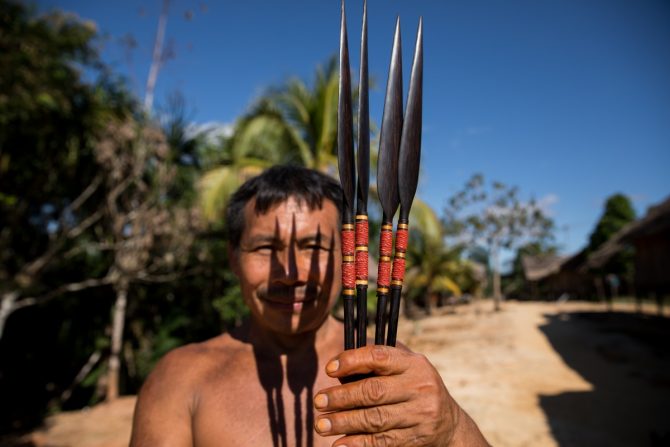
For our readers, can you describe on what is involved and some challenges in undertaking a photographic expedition into one of the most remote areas of the Amazon?
Tui Anandi: In preparation for these remote expeditions, it isn’t just about making the photos but about keeping them safe for later; this security means having multiple hard drives and laptops as backups in order to keep the media organized. Also, a huge amount of media is being produced over the weeks as it is often 6+ hours of shooting each day. Maintaining power is a priority as well. Since most of the villages do not have electricity, we must bring solar panels and batteries to optimize power. We used the brand ‘Goal Zero’ with their ultra lightweight and expedition-ready solar panel and battery kit, which allowed us to keep the equipment powered up. We traveled by canoe (often 6-8 hours during the middle of the day) and that acted as the perfect moment to charge the batteries and ourselves! Of course boat travel has its own risks, with many dangerous passages through narrow rivers where the way was swamped with fallen trees. When we came across these obstacles we always have to machete our way through. There were many close moments when ourselves and thousands of dollars worth of camera equipment were at risk if the canoe was to turn. It’s always an adventure!
After long days, my personal method of working was to say that the day is not finished until all material is backed up, which meant long evenings organizing files. But it also meant fun moments in the family house where we were staying since the children would gather round the laptop.
One story that comes to mind was our first night of the expedition arriving in San Juan. After a long day on the river we arrived at dusk at the village and began to set up our hammocks in the communal house. Within minutes the village elder, Antonio, sat myself, Jack and Mike down for an introduction to Matsés culture: this intro involved 4 huge blows of nene (tobacco snuff) up the nose which put us on the floor completely passed out!
The whole village was there (including a pet spider monkey), laughing and watching as we struggled for an hour or so. Looking back, this was very much a test, or a ‘welcome to our world’ moment – an exam I think we passed, and as a sign we were ready to be immersed into their culture. Antonio is now a good friend…

Mike van Kruchten: The first challenge of such a trip deep into the Amazon rainforest is equipment. You are looking at several cameras, different lenses, computers, solar panels, tripods etc. This load can easily become almost 30 kilos of equipment that you have to transport from village to village, keep dry and functional and, most importantly, charged. Since there is not much electricity in the villages we were always worried about power. Shooting 5-6 hours a day and making back ups every single day on the computer requires a lot of power. Working with solar panels did help but wasn’t a guarantee of enough power. This was a challenge every single day but luckily we had the right routine every day to make it work.

Of course, taking photos in a deeply humid rainforest wasn’t easy either! Days were long, hot and unpredictable. Long travels by boat or by foot made you more tired by the day, but every day was important and we had to deliver. Luckily, the team was strong and working with the Matsés was incredibly rewarding. Being able to document their culture, their way of life, their art made all the hard work worth it.
The resulting reporting and beautiful photography in Ancestral Transmission is an intimate glimpse into Matsés culture and daily life as never seen before. The images and videography convey a trust between the photographer and indigenous people that doesn’t feel staged or forced. How is this relationship and trust built?
Tui Anandi: The early stage of the relationship building means never getting the camera out; not photographing their life in an invasive way but by building a rapport together a way to record their art. Through this patience and using the art as a line, we connected with the artists and the process, which allowed us us to gain this proximity. Personally, I tried to be the most simple and discreet as little attention as possible in the village. I created individual relationships by being connecting to their daily life, taking time to share moments, make jokes, swim in the river, collect fruits, learn the language.. this activity all built trust and helped form genuine relationships.
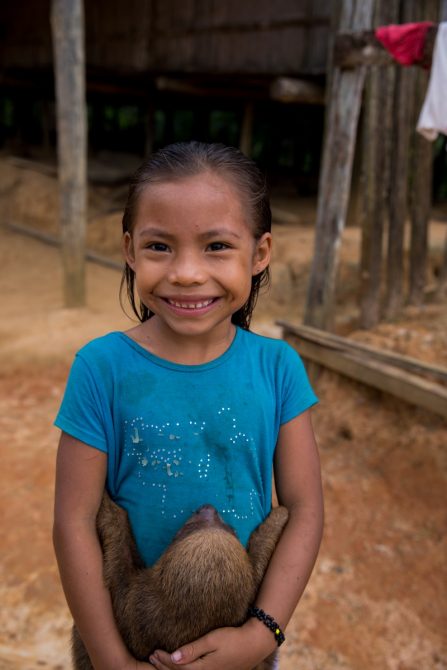
Mike van Kruchten: Establishing a relationship with the person you are photographing isn’t always easy. It requires time and a lot of patience, especially when it involves photographing indigenous people who are not very familiar with the concept of photography. We usually stayed several days in a village where the first days we merely spent on getting to know the people, explaining them what our objective was and really trying to work together with them rather than just taking a few interesting photos and leaving. This approach was just the beginning of a long-term, sustainable relationship. And by taking the time to explain this method, and to really get to know them, we were able to get closer and create more intimate content than ever before.
What are your impressions of the Matsés people? What surprised you? What didn’t conform to your expectations? What insights can you share about their culture and worldview?
Jack Wheeler: In general, what struck me most about the Matsés is how strong they are as a people in everything they do; both culturally speaking and of spirit, but also just being physically strong; the way in which women would come back from the chacra with 50 kilos of plantains on their backs; the way men had the power and strength to venture into the jungle with a bow and arrow and come back with meat to feed their families. For us, this physicality was incredible to see, as most of the communities we visit already have some level of dependency on the outside world. But the Matsés still fully maintain their self-sufficiency. And they are proud of that – an impressive type of pride that you rarely see today. It’s a pride in who they are and what they are capable of, which is a lot!
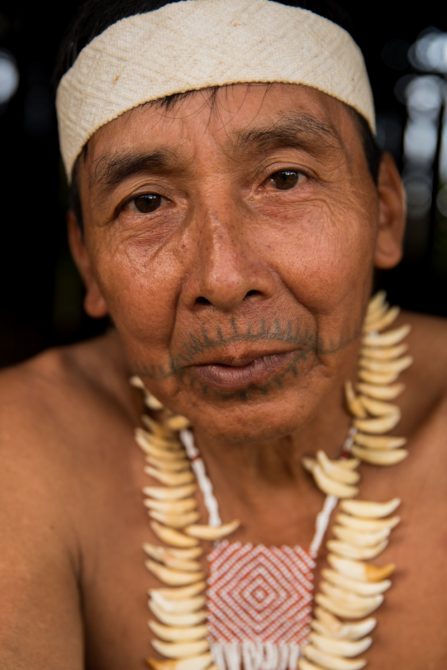
Mike van Kruchten: the Matsés made a very strong impression on me. Their way of life, living in the jungle, being self sufficient, far away from the outside world sounds like a tough life. For them it’s not, though. They feel home in the jungle, not caring much about “things,” never feeling stressed about many of our modern worries…Spending time with them made me happy and really put things in perspective. They live a simple but happy life and are very close to nature. This was truly amazing and wonderful to experience – and I’m feeling privileged to have taken part in this.
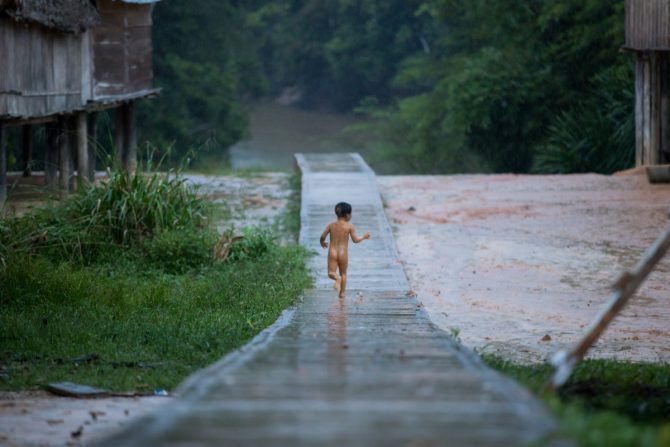
Impressions: Aesthetically talking, their physical aspects are amazing to witness and photograph since they have a strong and brave look in their eyes. You can tell they are warriors. This ‘look’ is not just physical strength but in their personalities–they often tested us, and once this trust was made, we were able to gain their respect–like the nunu story above–we were able to get close and do what we do!
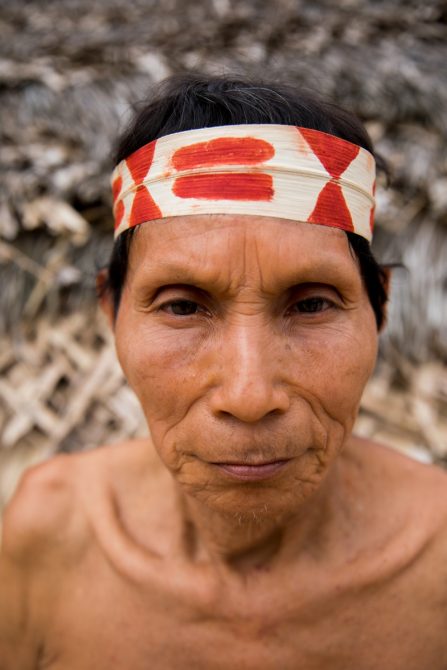
Cultural insight – the Matses are famously some of the most fearsome people in the jungle, known to be warriors and exceptional hunters. It was fascinating to gain a deeper understanding of their relationship with hunting and see the importance of this practice in their culture — from taking the acate poison to following the process of the arrow making, they are some of the best in the Amazon! Also to see the women make the other arts with incredible detail: it is this eye on the detail that is prominent throughout their culture.

In Xapiri’s work, are there common threads of concerns or aspirations you hear voiced among indigenous communities you work with?
Absolutely. The diversity among indigenous groups in the Amazon is immense, and yet, many of their modern struggles are sung to the same tune. Whether you’re in the rapidly growing city of Puerto Maldonado or four days up river by dugout canoe deep in the Valle de Javari, you often hear the same story from these varying groups: that one of the biggest struggles they face of keeping their cultures vibrant is the lack of interest among the youth in the traditional ways, and their preoccupations and at times romanticization of the ‘modern’ world. More than anything, they struggle with a generational gap. Elders continue to speak their native tongues, know the stories of their ancestors and how to thrive in the forest with little to no support from the outside world, while the youth are scrolling facebook, wanting to enter the cash economy, and while many speak their native tongue, you find many of them predominantly speaking Spanish.

But there is a response to this. Culture is not a static thing, nor are indigenous communities stuck in a timeless past. At Xapiri, we think one of the greatest challenges to the future of indigenous communities is to adapt traditions to fit into this modern context, without losing the core substance and integrity from which they originate; finding ways to increase representation of indigenous identity brings perceived value back to these communities, particularly among the youth; finding ways to attach commercial value to these artistic traditions while sparking interest among the youth to carry these traditions forward.

With proper and empowered representation, the future generations of indigenous communities can adapt to the modern world without assimilating fully into it.
In March 2019, Xapiri held an exhibition entitled Time is Life, centering on Matsés art and culture, that was held in the Qorikancha in Cusco. Can you share some of your experiences and perspectives on the event?
Focusing on Matsés art and culture, Time Is Life represents Xapiri’s first full-blown art exhibition. This marked a big milestone for both the Matsés as an ethnic group–as it represented the first time they have had comprehensive representation outside of their traditional territory–but this was truly just as much an important milestone for us at Xapiri. The exhibition was held at Qoriqancha, a location that has held significant cultural weight and importance for the past several centuries in Cusco. The principle sun temple during the Incan empire, Qoriqancha was later turned into a Spanish monastery during colonial days, and now is one of the most important museums in Cusco. We had most of the entire second floor to showcase our exhibition, giving us the opportunity to curate a significant amount of space that was both photographical but also content-based; allowing us to really craft an entire story of the Matsés, and introducing people to this little-known ethnic group.
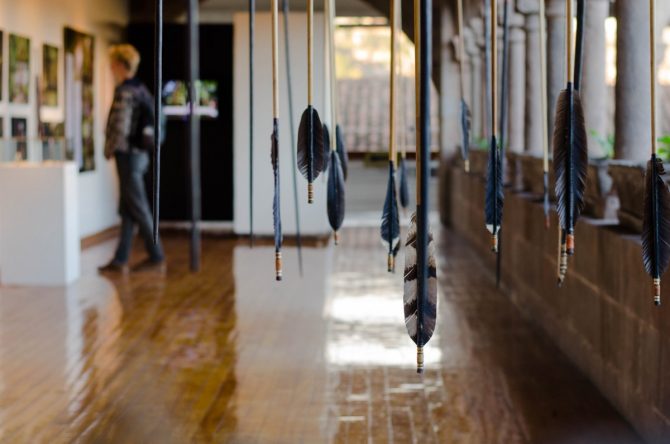
The exhibition was held for 7 weeks, meaning that thousands of people–both local Peruvians as well as foreigners–passed through this space, and learned, often for their first time, about the Matsés. The feedback was consistently positive: how well produced it was aesthetically, but perhaps more importantly, how informative and mind-expanding this exhibition was for people. It significantly increased our foot traffic in our shop, and proved to be a great conversation starter that got locals and foreigners alike thinking critically about the Amazon and its inhabitants and the work that we do.
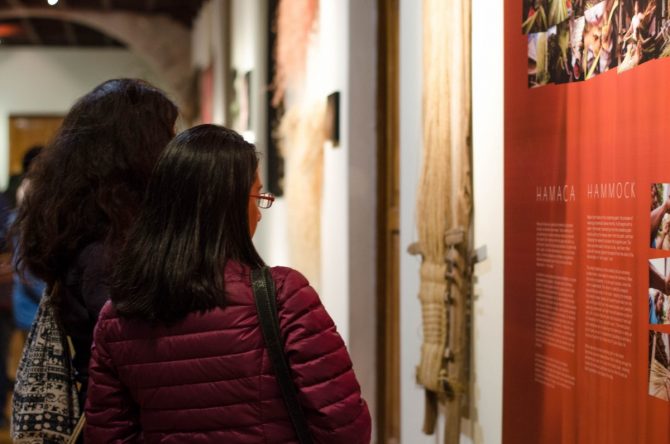
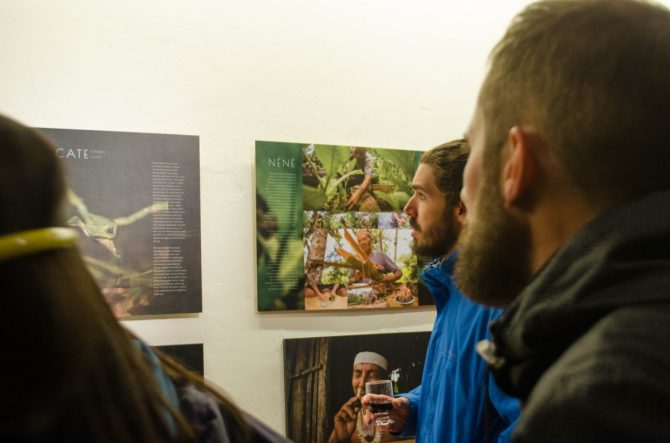
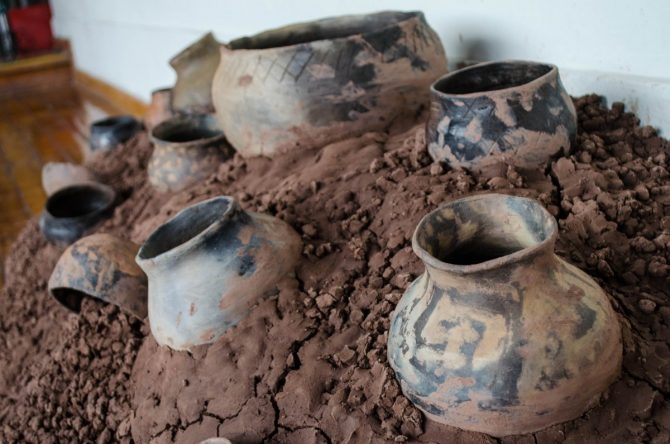
Another joy of the exhibition was bringing two Matsés elders down from Matsés land to Cusco for the opening week. Antonio and Margarita, husband and wife, visited Cusco for their first time. Being able to speak for themselves at the inaugural night, presenting themselves what this exhibition means to them and speaking on behalf of their culture, was a powerful and potent moment: both for them in bolstering their own agency, but for participants in being able to hear from indigenous individuals themselves and not only seeing a representation of them. The whole week was a blast as well–sharing Incan culture and landmarks with Antonio and Margarita was a worthwhile cultural exchange, as they had the opportunity to learn about the Incan empire, and see firsthand another part of Peru.

While the Matsés are indigenous to Peru, the vast majority of even Peruvians have never heard of them, much less outsiders. So to be able to bring this exhibition to Cusco, which is in many ways the cultural capital of the country, really allowed us to give voice to the Matsés in a groundbreaking way. With its success, we’re looking forward. Some of our team will be back in Matsés land in August, discussing with Acaté and the Matsés how we can further develop this exhibition to take it to new places. If all goes according to plan, you’ll find it in Lima later this year, and then Europe (and potentially the US) in 2020.
What is planned next for Xapiri? How can people best support your work?
We’ve got a lot of things happening in the upcoming future. Our first successful museum exhibition in Qorikancha with the Matsés has gotten us inspired and maybe even a little antsy in looking for ways to take it on the road: bringing this exhibition to Lima, Bogota, New York, London – you name it. Our feedback from exhibition-goers has really fortified our sense that this type of exhibition can really spread awareness far and wide about communities like the Matsés, and inspire the positive change that is so core to our mission. We really are that bridge for them to the outside world, so putting the word out there and connecting with people around the world that want to see this type of work in their city and working with us to bring it there is one way to get involved.
We also have plans to be back in Matsés territory for a second expedition in late August to continue to strengthen relationships and create further content to share with our networks. Of course, we also work with several other indigenous groups, and we’ll be getting out of our Cusco hub and into their territories as well over the coming months to carry out further documentation for future campaigns.
And you know, we just continue doing what we’re doing. Our Cusco hub and art gallery has a pretty strong foundation at this point, and we look forward to continuing to cultivate that, and create it to be one of the key points for Amazonian news, Amazonian activism, and Amazonian awareness within all of Latin America.
As our Cusco hub continues to grow, we’ve encountered many folks from around the world that want to get more involved from afar, and support us financially and otherwise. One thing that is core to who we are is that we are a social enterprise and not an NGO, and therefore, don’t take donations. However, we’re currently working on an Art Membership of sorts, which would allow people to make financial contributions and in return become Xapiri Members, with specific perks tied to different tiers. The idea is that through it, you become apart of a larger Xapiri network, learn more about the different ethnic groups we work with, have access to exclusive indigenous media and reports, receive little gifts from our shop throughout year, and stay connected to what we–and others like us–are up to. We’re still fleshing out the details, but join our newsletter and you’ll be among the first to hear about our launch date.
As we grow, we carry with us what we originally set out to do: to be a force of good for indigenous populations by being the best allies we can be. We will continue to fight and advocate for indigenous rights by providing a platform of representation for them.
All of the beautiful Matsés handicrafts available through Xapiri are crafted by individual Matsés artisans and come from the heart of the rainforest. They make meaningful and special gifts. Your purchase directly supports that livelihood of the indigenous protectors of the Amazon.
Acaté is an on-the-ground conservation organization that works directly in a true and transparent partnership with the Matsés indigenous people to maintain their self-sufficiency and way of life. The Matsés safeguard one of the great areas of rainforest on the planet, protecting a region of over 3 million acres in Perú alone and shielding some of the last remaining uncontacted tribes in voluntary isolation from unwanted encroachment from the outside world. Donations are tax-deductible and go directly to fund these on-the-ground initiatives that operate at the leading edge of conservation with unparalleled transparency.
Stay tuned soon for more reporting on our work including a major update on the landmark Matsés Indigenous Mapping Initiative and the sustainable economic development programs. If you missed it, take a look at our October 2018 Field Report highlighting the completion of eight reader books, illustrated and written by Matsés authors based on narratives provided by Matsés elders. More than doubling the amount of native language books available for Matsés children, each book is designed to support native language literacy and pass down traditional rainforest knowledge!
All content and images copyright 2019 Acaté / Xapiri / Tui Anandi / Mike van Kruchten

